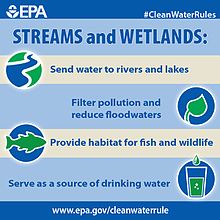Since it was signed into law by President Nixon in 1972, the Clean Water Act has protected America’s families and communities by preventing unchecked pollution from contaminating our waterways and drinking water sources. It has been one of the most successful environmental protections in our history.
Every day, our families count on clean water for drinking, cooking, and bathing. Our local businesses depend on clean water—from our breweries, restaurants, and family farms to fishing, hunting, and outdoor recreation businesses. The health of our waters, families, and communities are tied together throughout the South. For North Carolina’s coastal residents – our culture depends on clean water.
Allowing pollution into upstream waters spells trouble for everyone downstream. Pollution dumped by industry flows from smaller streams into our rivers and lakes, across state lines, and downriver, contaminating waters used by families and communities for drinking, bathing and fishing.
The best way to protect clean water is to stop harmful pollution at its source.
Dumping unlimited pollution into our groundwater, rivers, and lakes—even if it’s a smaller water body or only flows seasonally — is dangerous and irresponsible.
Current U.S. law sets basic limits on industrial pollution of streams, rivers, marshes, and lakes, but at the bidding of industry and politicians, the federal government is rewriting our water laws to protect big polluters instead of our communities and families.
We can’t trust polluters to regulate themselves. We need commonsense clean water protections to prevent harmful pollution and protect the water we drink and depend on.
What is the Clean Water Rule?
The Clean Water Rule, also known as the Waters of the United States was passed by the EPA in 2015 to help regulators gain clarity on which waters are protected under the Clean Water Act. Before enacting the rule, EPA held more than 400 stakeholder meetings and provided a 200-day comment period, during which more than one million comments were received, 87% of which supporting it. The final rule incorporated 1,200 peer-reviewed scientific studies.

The Clean Water Rule clarifies the following as protected waters under the Clean Water Act:
- Wetlands adjacent to navigable waters or continuously-flowing tributaries
- Intermittently flowing tributaries (those that flow seasonally, for instance) and adjacent wetlands, if the stream has an identifiable bed, bank and high-water mark
- Wetlands not adjacent to navigable waters or tributaries IF: in a 100-year floodplain or within 4,000 feet of navigable water or tributary to which analysis finds a significant hydrological or ecological link.
- Significant wetland systems: prairie potholes, western vernal pools, Carolina and Delmarva bays, Texas coastal prairie wetlands and pocosins – unless analysis shows the system does not have a significant hydrological or ecological link to a navigable water
More information can be found on the Southern Environmental Law’s website.
Why It’s a Clean Water Matter
Without these protections, industry can dump directly into these waterways, leaving North Carolina’s drinking water supplies, vital fish habitat, ecologically significant wetland systems, and recreational areas vulnerable to pollution – threatening our health, our economy and our way-of-life.
Status
January 31, 2018: With support from large agricultural industries, chemical fertilizer corporations and real estate developers, EPA Secretary Scott Pruitt suspended the rule for two years, while the agency works to finalize a new ‘Trump Rule.’
February 6, 2018: The Southern Environmental Law Center, on behalf of several partners, filed a challenge to this action in U.S. District Court for the District of South Carolina.
August 16, 2018: a federal judge in South Carolina ruled in favor of clean water, putting the Clean Water Rule back in effect for the South and nearly half the country. This ruling does not apply to 24 states where other legal challenges are pending.
The Administration is still fighting to dismantle the Clean Water Act. “The administration’s suspension of standards under the Clean Water Act was the first of several steps the administration plans to take to repeal long-standing clean water protections,” according to the SELC.
Take Action:
Sign the SELC’s PETITION to PROTECT OUR NATION’S WATERS!

